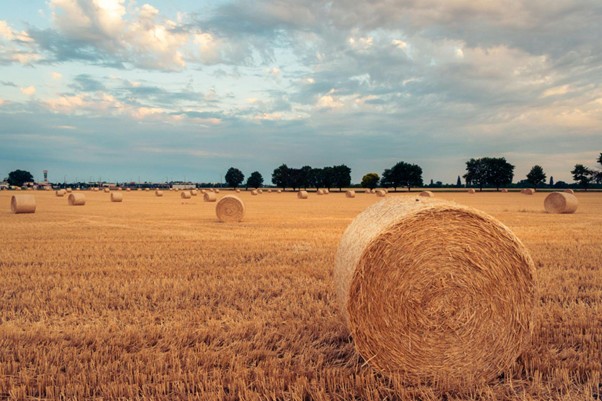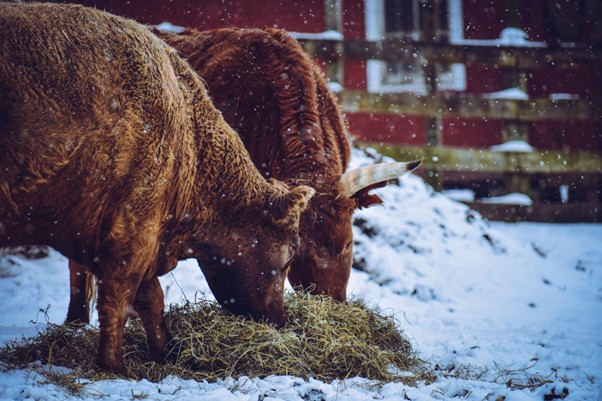Types of Hay to Choose for Your Livestock

There are three main types of hay for your livestock: legume hay, grass hay, and mixed hay. Choosing the right type is essential to ensure your animals get the nutrition they need to stay healthy, active, and productive.
Each type offers unique nutrients, so it's essential to match the hay to your livestock's species, age, and life stage. Another factor farmers should not overlook is the quality of the hay. Fresh, clean, and well-preserved hay is the foundation of good nutrition and keeping your livestock healthy.
Understanding Hay Categories

When it comes to feeding your livestock, not all hay is the same. Understanding the differences between grass, legume, and mixed hay helps you choose the proper feed for every animal's needs.
Grass Hay
Grass hays like timothy, orchardgrass, and bermudagrass are high in fiber and lower in protein. They're ideal for animals that need a balanced, lower-calorie diet, such as horses, sheep, and maintenance cattle.
Legume Hay
Legume hays such as alfalfa and clover are rich in protein, calcium, and energy. They're perfect for growing animals, lactating cows, dairy goats, and breeding livestock that need a nutritional boost.
Mixed Hay
Mixed hays combine both grass and legume varieties, offering a balance of fiber and protein. They're great for multi-species farms or animals with moderate energy needs, providing variety and balanced nutrition in every bite.
Most Common Types of Hay for Livestock
Here are the most common types of hay for livestock to consider:
Alfalfa Hay
Alfalfa hay is rich in protein, calcium, and energy, making it an excellent choice for growing livestock, lactating cows, and high-producing dairy goats. Its dense nutrient profile supports rapid growth, milk production, and overall animal health. Properly cured alfalfa is soft and palatable, encouraging better feed intake.
Clover Hay
Clover hay provides a soft texture and excellent digestibility. It contains high protein and moderate fiber, making it suitable for horses, sheep, and goats. Clover hay is often mixed with grass hays to improve palatability while maintaining nutritional balance.
Timothy Hay
Timothy hay is a grass hay with moderate protein and high fiber, ideal for maintaining horses, older livestock, and animals on maintenance diets. Its fibrous structure supports healthy digestion and helps prevent obesity in animals that require lower-calorie feed.
Orchard Grass Hay
Orchard grass is leafy, soft, and highly palatable. It provides moderate protein and energy levels, making it a versatile choice for horses, cattle, and small ruminants. Its slow growth and high digestibility make it a preferred hay for animals with sensitive digestive systems.
Bermuda Grass Hay
Bermuda grass thrives in warm climates and produces hay with moderate fiber and energy. It is well-suited for cattle and horses in southern regions and provides a reliable forage source during hot seasons. When harvested at the proper maturity, it balances digestibility with yield.
Fescue, Brome, Oat, and Ryegrass Hays
Fescue, brome, oat, and ryegrass hays are used as forage for livestock and offer varied fiber, protein, and energy levels depending on the species and local conditions. They are suitable for cattle, horses, and sheep, providing flexible feeding options based on regional availability and livestock requirements.
Mixed or Blended Hay
Mixed hay combines grass and legume varieties, offering a balance of fiber, protein, and energy. It is cost-effective and ideal for multi-species farms or animals with moderate nutritional requirements, giving livestock a diverse and balanced diet in every bite.
Comparing Nutritional Values of Different Hay Types

Different hay types offer varying levels of protein, fiber, calcium, and energy. Understanding these differences helps farmers select the right hay to meet their livestock's specific nutritional needs.
Selecting the Ideal Hay for Your Livestock
Not all animals have the exact nutritional requirements, which is why matching hay type to species, life stage, and activity level is crucial.
Best Hay for Cattle (Beef & Dairy)
Cattle benefit from alfalfa, clover, bermuda, and fescue hays. These provide a balance of protein and energy needed for growth and milk production. High-quality legume hay is essential for lactating dairy cows, while grass hays are suitable for maintenance and long-term feeding.
Best Hay for Horses
Horses thrive on timothy, orchard grass, and mixed hay. Focus on soft, leafy hay that is free from dust and mold, as poor-quality hay can cause respiratory issues or digestive problems. Balanced fiber content is essential to maintain healthy digestion and prevent obesity.
Best Hay for Sheep and Goats
Sheep and goats do well on moderate-protein grass hays, which support growth and milk production without overloading them with excessive energy or calcium. Mixing small amounts of legume hay can be beneficial, but it should be introduced gradually.
Best Hay for Rabbits
For rabbits, grass hay is preferred, as legumes like alfalfa can lead to bloat and digestive upset if fed excessively. Providing unlimited high-quality grass hay is key to dental health and proper digestion.
Choosing Hay for Young, Pregnant, or Lactating Animals
Animals that are young, pregnant, or lactating have higher protein, energy, and calcium needs. Legume hays like alfalfa or high-quality mixed hays are recommended to support growth, fetal development, and milk production. Constantly monitor intake and adjust based on body condition.
Factors That Affect Hay Quality and Nutritional Value
- Harvest Time: Younger, leafy hay is more nutritious.
- Curing and Storage: Properly dried and stored hay prevents mold and nutrient loss.
- Moisture Content: Excess moisture can lead to spoilage and mycotoxin contamination.
- Leaf-to-Stem Ratio: More leaves mean higher protein and digestibility.
How to Choose and Buy Hay Like a Pro?

Buying hay isn't just picking up a bale; it's about ensuring your livestock gets high-quality, nutritious feed that supports their health and productivity. Here's how to approach it like a pro:
Know Your Livestock's Needs
- Consider species, age, life stage, and activity level.
- Match hay type (grass, legume, or mixed) to their nutritional requirements.
Inspect Hay Quality
- Look for bright green color, fresh aroma, and soft leaves.
- Avoid dusty, moldy, or overly coarse hay, which can cause health problems.
- Check for foreign materials or weeds that could be harmful.
Check Nutritional Content
- Consider protein, fiber, calcium, and energy levels.
- Ask for a lab analysis if buying in bulk, especially for dairy or high-production animals.
Consider Storage and Moisture
- Hay should be properly cured and dry before storage.
- Store in a covered, ventilated area to prevent mold, spoilage, and nutrient loss.
Buy the Right Quantity and Timing
- Purchase enough to last through the season, but avoid long storage that can reduce quality.
- Plan purchases around local growing seasons for the freshest hay.
Compare Prices and Sources
- Compare hay prices, and buy from local farmers or co-ops rather than large distributors.
- Consider mixed or blended hay to balance cost with nutritional value.
Track Hay Costs and Inventory Easily with FarmKeep
FarmKeep helps small farmers and homesteaders stay organized, save money, and make smarter feeding decisions with easy-to-use tracking tools.
With FarmKeep, you can:
- Monitor hay usage by week or month to see exactly how much you're buying and feeding.
- Track animal consumption to identify which species or groups eat the most and during which seasons.
- Keep an eye on feed costs with detailed breakdowns by animal type, batch, or supplier.
- Set reminders and tasks to restock hay before supplies run low.
- Record supplier details like cutting quality, delivery contacts, and preferred bale types.
- Analyze trends over time to optimize feeding efficiency and reduce waste.
FAQs
What's the best type of hay for livestock?
The best type of hay for your livestock depends on the animal species, age, and life stage. Legume hay is high in protein, grass hay is high in fiber, and mixed hay offers a balanced option.
Is grass hay or legume hay better?
Neither is better than the other. Grass hay is ideal for maintenance and digestion, while legume hay supports growth, lactation, and higher nutritional needs.
What is mixed hay, and why use it?
Mixed hay is one of the types of hay that combines grass and legume varieties. It is used to create a more balanced nutritional profile.
How do I know if hay is of good quality?
To get good-quality hay, you must look for a bright green color, soft leaves, and a pleasant smell. Make sure there is minimal dust and there is no mold or foreign material.
How long can hay be stored safely?
Hay should be properly dried and stored; hay can last 6–12 months, depending on storage conditions.
How much hay should I feed daily?
Typically, livestock eat 2–4% of their body weight in hay per day, adjusted by species, age, and activity.
Can I mix different hay types in one diet?
Yes, you can combine grass and legume hay to balance protein and fiber for the overall nutrition of your animals.
What are the signs of moldy or spoiled hay?
Common signs are a musty smell, black or white spots, a dusty texture, or clumped moisture, which indicate spoilage.
Is it okay to feed wet or damp hay?
No, you must not feed wet hay to your animals. Wet hay contains mold, which can cause respiratory and digestive problems and potentially fatal diseases like botulism, and in some cases, it is also a fire hazard.



